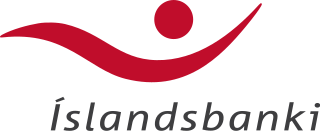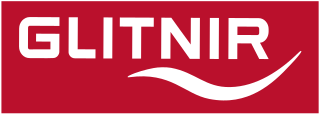See also
| Sovereign states |
|
|---|---|
| States with limited recognition | |
| Dependencies and other entities | |
The following is a list of banks in Iceland.

Íslandsbanki is an Icelandic bank with roots tracing back to 1875, formerly being the domestic part of Glitnir banki hf., but on 15 October 2008 being split from the bankrupt Glitnir and reestablished into a new independent bank. The sole operations of the bank is to manage a branch network in Iceland, with a 20%-40% market share across all domestic franchise areas. As of 2022, the bank has 12 branches around Iceland.

Landsbanki, also commonly known as Landsbankinn which is now the name of the current rebuilt bank, was one of the largest Icelandic commercial banks that failed as part of the 2008–2011 Icelandic financial crisis when its subsidiary sparked the Icesave dispute. On October 7, 2008, the Icelandic Financial Supervisory Authority took control of Landsbanki and created a new bank for all the domestic operations called Nýi Landsbanki so that the domestic bank could continue to operate, the new bank continued to operate under the Landsbanki name in Iceland.

The Central Bank of Iceland is the central bank or reserve bank of Iceland. It has served in this capacity since 1961, when it was created by an act of the Alþingi out of the central banking department of Landsbanki Íslands, which had the sole right of note issuance since 1927 and had conducted only limited monetary policy.
The Nasdaq Iceland, formerly known as the Iceland Stock Exchange (XICE), is a stock exchange located in Iceland. It was established in 1985 as a joint venture of several banks and brokerage firms on the initiative of the central bank. Trading began in 1986 in Icelandic government bonds, and trading in equities began in 1991. Equities trading increased rapidly thereafter. A wide variety of firms are currently listed on the exchange, including firms in retail, fishing, transportation, banks, insurance and numerous other areas. Because of the small size of the Icelandic economy and the low cost of public listing, many of the companies traded on the XICE are relatively small and are relatively illiquid.
Kaupthing Bank was a major international Icelandic bank, headquartered in Reykjavík, Iceland. It was taken over by the Icelandic government during the 2008–2011 Icelandic financial crisis and the domestic Icelandic based operations were spun into a new bank New Kaupthing, which was subsequently renamed Arion Banki. All the non-Icelandic assets and debts remained with the now defunct Kaupthing Bank. Prior to its collapse it also allegedly loaned money to various parties with the purpose of buying Kaupthing shares.

Glitnir was an international Icelandic bank. It was created by the state-directed merger of the country's three privately held banks - Alþýðubanki, Verzlunarbanki and Iðnaðarbanki - and one failing publicly held bank - Útvegsbanki - to form Íslandsbanki in 1990. At the time, Íslandsbanki was the only major privately held commercial bank in Iceland. It was publicly listed on the Iceland Stock Exchange, in 1993. Íslandsbanki subsequently merged with FBA Icelandic Investment Bank in 2000.

The Icesave dispute was a diplomatic dispute between Iceland, and the Netherlands and the United Kingdom that began after the privately owned Icelandic bank Landsbanki was placed in receivership on 7 October 2008. As Landsbanki was one of three systemically important financial institutions in Iceland to go bankrupt within a few days, the Icelandic Depositors' and Investors' Guarantee Fund (Tryggingarsjóður) had no remaining funds to make good on deposit guarantees to foreign Landsbanki depositors who held savings in the Icesave branch of the bank.

The OMX Iceland 15 is a defunct stock market index which consisted of a maximum of 15 companies listed on the OMX Iceland Stock Exchange with the highest market capitalization. At the final official review of the index effective in January 2009, 12 companies made up the index, four of which were Faroese. Calculated daily since 1998 and starting at 1,000 points, it was a market value-weighted index and the constituent companies were reviewed twice a year.

The Financial Supervisory Authority is the single supervisory authority for the financial sector in Iceland. Companies regulated by the authority are commercial banks, savings banks, insurance companies, insurance brokers, credit institutions, securities firms, securities brokers, mutual funds and pension funds management companies and other entities authorized to receive deposits. The current CEO is Ms. Unnur Gunnarsdóttir, who succeeded the controversial Gunnar T. Andersen in March 2012. Deputy CEO Ragnar Haflidason succeeded Jónas Fr Jónsson in October 2008 and Gunnar T Andersen took over as CEO in April 2009. The first CEO was Pall Gunnar Palsson, who directed from 1999 to 2005.

The Icelandic financial crisis was a major economic and political event in Iceland that involved the default of all three of the country's major privately owned commercial banks in late 2008, following their difficulties in refinancing their short-term debt and a run on deposits in the Netherlands and the United Kingdom. Relative to the size of its economy, Iceland's systemic banking collapse was the largest experienced by any country in economic history. The crisis led to a severe economic slump in 2008–2010 and significant political unrest.
Banking in Iceland faced a crisis in 2008, which resulted in the government taking over three of its largest commercial banks.
Arion Banki hf. formerly Nýja Kaupþing hf or New Kaupthing is an Icelandic bank with roots tracing back to 1930. The bank operates in the Greater Reykjavík area as well as in the largest urban areas around the country. In 2016 the bank had the third largest market share of the current accounts in Iceland (30%), behind Landsbankinn (36.1%) and Íslandsbanki (31%). The Bank has 21 branches all over the country and over 100,000 customers.
The Icelandic "outvasion" was the period in the economic history of Iceland between 2000 and the onset of its financial crisis in October 2008. With the privatisation of the Icelandic banks being advantageous for investors, there was a large supply of cheap loan capital on the international market. A clause in the agreement with the European Economic Area stipulated the free flow of capital to and from Iceland.
A referendum on the repayment of loan guarantees by Iceland to the governments of the United Kingdom and the Netherlands over the failure of the Icesave bank was held in Iceland on 9 April 2011. This was the second referendum on the issue after a previous one was held in March 2010. After the referendum failed to pass, the British and Dutch governments said that they would take the case to the European courts.

The following is a timeline of the Icelandic financial crisis which began in earnest in mid September 2008. The combined assets of the three largest Icelandic banks amounted to ten times the country's total gross domestic product (GDP) at the time of their collapse. Two-thirds of the banks liabilities were denominated in a foreign currency. When the world's credit markets dried up, the banks were unable to refinance their loans and the government, as a lender of last resort, was unable to offer backing to the privately owned banks.
Jón Ásgeir Jóhannesson is an Icelandic businessman and former CEO of Baugur Group.
Sigurður Einarsson is an Icelandic economist, businessman, and one-time chairman of the failed bank Kaupþing, and has been called 'Iceland's most controversial banker'. He was among the so-called Icelandic 'raiding Vikings' (útrásarvíkingar) until the 2008–2011 Icelandic financial crisis, being paid an average of twelve million Icelandic krónur per month in 2007. In a statement which he issued on October 9, 2008, he attributed the collapse to Kaupþing to a 'chain of events which no-one foresaw or could have controlled'.
Ármann Þorvaldsson was an Icelandic badminton player and was the UK CEO of Kaupthing Bank at the time of its collapse in 2008.
The following lists events that happened in 2008 in Iceland.